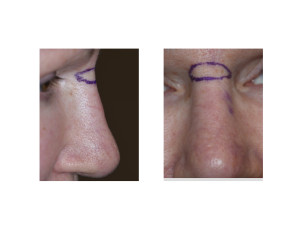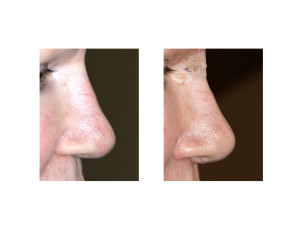Aging affects all facial tissues to some degree including the nose. The effects of time on the nose occurs at the nasal tip where the cartilages are help up by ligaments to the cartilage structures of the middle value. The effects of age on the nasal tip are that some increased droop can occur as the ligaments weaken or stretch. This makes the tip go down slightly and the nasolabial angle lessens.
The typical treatment for a drooping nasal tip, at any age, is to lift and support the lower alar cartilages in a more upward position. This could involve trimming of the upper edge of the cartilage, suture suspension or a combination of both. This us usually done from below through an open rhinoplasty approach.


While the removal of nasal skin and the creation of a fine line scar in the upper nose may seem ‘radical’, it really is not. The location of a fine line scar is at the frontonasal junction which is a natural skin line when one lifts their nose or squints. Many older patients already have a fine line skin wrinkle there already.
A nasal lift is a very uncommon procedure that would only be for a very specific type of nose patient. One must be older, have an established frontonasal crease and desire only a minor amount of nasal tip rotation.
Dr. Barry Eppley
Indianapolis, Indiana


